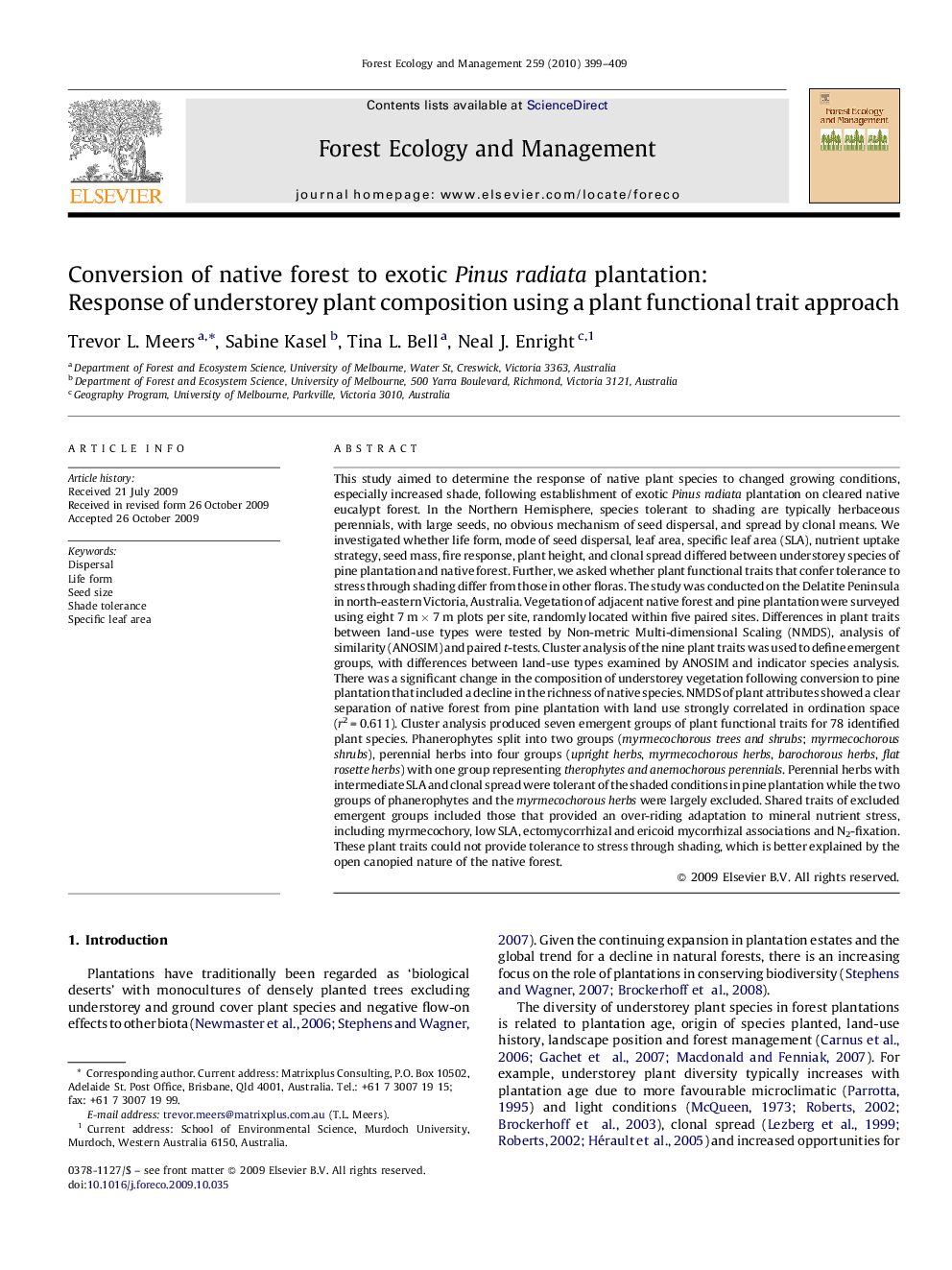| کد مقاله | کد نشریه | سال انتشار | مقاله انگلیسی | نسخه تمام متن |
|---|---|---|---|---|
| 10250570 | 159322 | 2010 | 11 صفحه PDF | دانلود رایگان |
عنوان انگلیسی مقاله ISI
Conversion of native forest to exotic Pinus radiata plantation: Response of understorey plant composition using a plant functional trait approach
دانلود مقاله + سفارش ترجمه
دانلود مقاله ISI انگلیسی
رایگان برای ایرانیان
کلمات کلیدی
موضوعات مرتبط
علوم زیستی و بیوفناوری
علوم کشاورزی و بیولوژیک
بوم شناسی، تکامل، رفتار و سامانه شناسی
پیش نمایش صفحه اول مقاله

چکیده انگلیسی
This study aimed to determine the response of native plant species to changed growing conditions, especially increased shade, following establishment of exotic Pinus radiata plantation on cleared native eucalypt forest. In the Northern Hemisphere, species tolerant to shading are typically herbaceous perennials, with large seeds, no obvious mechanism of seed dispersal, and spread by clonal means. We investigated whether life form, mode of seed dispersal, leaf area, specific leaf area (SLA), nutrient uptake strategy, seed mass, fire response, plant height, and clonal spread differed between understorey species of pine plantation and native forest. Further, we asked whether plant functional traits that confer tolerance to stress through shading differ from those in other floras. The study was conducted on the Delatite Peninsula in north-eastern Victoria, Australia. Vegetation of adjacent native forest and pine plantation were surveyed using eight 7 m Ã 7 m plots per site, randomly located within five paired sites. Differences in plant traits between land-use types were tested by Non-metric Multi-dimensional Scaling (NMDS), analysis of similarity (ANOSIM) and paired t-tests. Cluster analysis of the nine plant traits was used to define emergent groups, with differences between land-use types examined by ANOSIM and indicator species analysis. There was a significant change in the composition of understorey vegetation following conversion to pine plantation that included a decline in the richness of native species. NMDS of plant attributes showed a clear separation of native forest from pine plantation with land use strongly correlated in ordination space (r2 = 0.611). Cluster analysis produced seven emergent groups of plant functional traits for 78 identified plant species. Phanerophytes split into two groups (myrmecochorous trees and shrubs; myrmecochorous shrubs), perennial herbs into four groups (upright herbs, myrmecochorous herbs, barochorous herbs, flat rosette herbs) with one group representing therophytes and anemochorous perennials. Perennial herbs with intermediate SLA and clonal spread were tolerant of the shaded conditions in pine plantation while the two groups of phanerophytes and the myrmecochorous herbs were largely excluded. Shared traits of excluded emergent groups included those that provided an over-riding adaptation to mineral nutrient stress, including myrmecochory, low SLA, ectomycorrhizal and ericoid mycorrhizal associations and N2-fixation. These plant traits could not provide tolerance to stress through shading, which is better explained by the open canopied nature of the native forest.
ناشر
Database: Elsevier - ScienceDirect (ساینس دایرکت)
Journal: Forest Ecology and Management - Volume 259, Issue 3, 25 January 2010, Pages 399-409
Journal: Forest Ecology and Management - Volume 259, Issue 3, 25 January 2010, Pages 399-409
نویسندگان
Trevor L. Meers, Sabine Kasel, Tina L. Bell, Neal J. Enright,